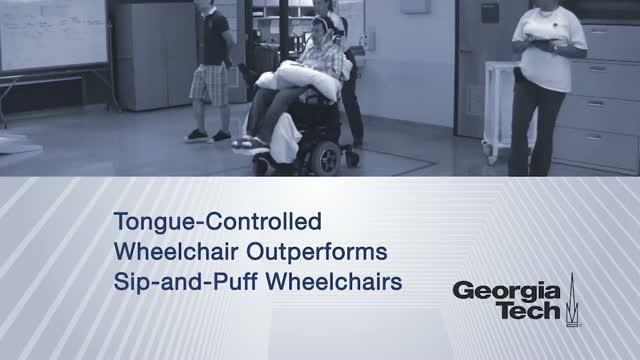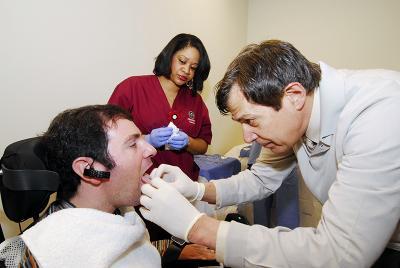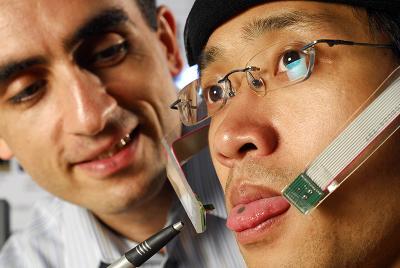The research team had subjects complete a set of tasks commonly used in similar clinical trials. Subjects in the trials were either able-bodied or people with tetraplegia.
"By the end of the trials, everybody preferred the Tongue Drive System over their current assistive technology," said Joy Bruce, manager of Shepherd Center's Spinal Cord Injury Lab and co-author of the study. "It allows them to engage their environment in a way that is otherwise not possible for them."
Researchers compared how able-bodied subjects were able to execute commands either with the Tongue Drive System or with a keypad and mouse. For example, targets randomly appeared on a computer screen and the subjects had to move the cursor to click on the target. Scientists are able to calculate how much information is transferred from a person's brain to the computer as they perform a point-and-click task. The performance gap narrowed throughout the trial between the keypad and mouse and the Tongue Drive System.
For the first time, the research team showed that people with tetraplegia can maneuver a wheelchair better with the Tongue Drive System than with the sip-and-puff system. On average, the performance of 11 subjects with tetraplegia using the Tongue Drive System was three times faster than their performance with the sip-and-puff system, but with the same level of accuracy, even though more than half of the patients had years of daily experience with sip-and-puff technology.
"That was a very exciting finding," Ghovanloo said. "It attests to how quickly and accurately you can move your tongue."
The idea for piercing the tongue with the magnet was the inspiration of Anne Laumann, M.D., professor of dermatology at Feinberg and a lead investigator of the Northwestern trial. She had read about an early stage of Tongue Drive System using a glued-on tongue magnet. The problem was the magnet fell off after a few hours and aspiration of the loose magnet was a real danger to these users.
"Tongue piercing put to medical use — who would have thought it? It is needed and it works!" Laumann said.

Maysam Ghovanloo, an associate professor in the School of Electrical and Computer Engineering at the Georgia Institute of Technology, talks about the results from a new clinical trial on the Tongue Drive System.
(Photo Credit: Georgia Institute of Technology)
The experiments were repeated over five weeks for the able-bodied test group, and over six weeks for the tetraplegic group. All of the subjects with tetraplegia were able to complete the trial, which Ghovanloo called an "exciting" and "major finding."
The tetraplegic group was using the Tongue Drive System just one day each week, but their improvement in performance was dramatic.
"We saw a huge, very significant improvement in their performance from session one to session two," Ghovanloo said. "That's an indicator of how quickly people learn this."
Experiments on the Tongue Drive System to date have been done in the lab or hospital. In future studies, scientists will test how the Tongue Drive System performs outside of the controlled clinical environment. The research team hopes to test how patients maneuver with the Tongue Drive System in their homes and other environments.
The Tongue Drive System isn't quite ready for commercialization, but Ghovanloo's startup company, Bionic Sciences, is working with Georgia Tech to move the technology forward.
Ghovanloo is the founder of the GT-Bionics Laboratory, where his team is experimenting with other devices to improve the quality of life for individuals with disability.
"All of my projects are related to helping people with disabilities using the latest and greatest technologies," Ghovanloo said. "That's my goal in my professional life."
Disanto hopes that the one day he'll be able to use a tongue-powered wheelchair outside of the hospital, which would help him gain some independence he lost after his diving accident.
"The Tongue Drive System will greatly increase my quality of life when I can start using it everywhere I go," Disanto said. "With the sip-and-puff system, there is always a straw in front of my face. With the Tongue Drive, people can see you, not just your adaptive equipment."

Jason Disanto receives a tongue piercing so he can test the Tongue Drive System.
(Photo Credit: Shepherd Center.)

Georgia Tech assistant professor Maysam Ghovanloo (left) points to a small magnet attached to graduate student Xueliang Huo's tongue that allows him to operate a computer mouse and powered wheelchair.
(Photo Credit: Gary Meek)
Source: Georgia Institute of Technology